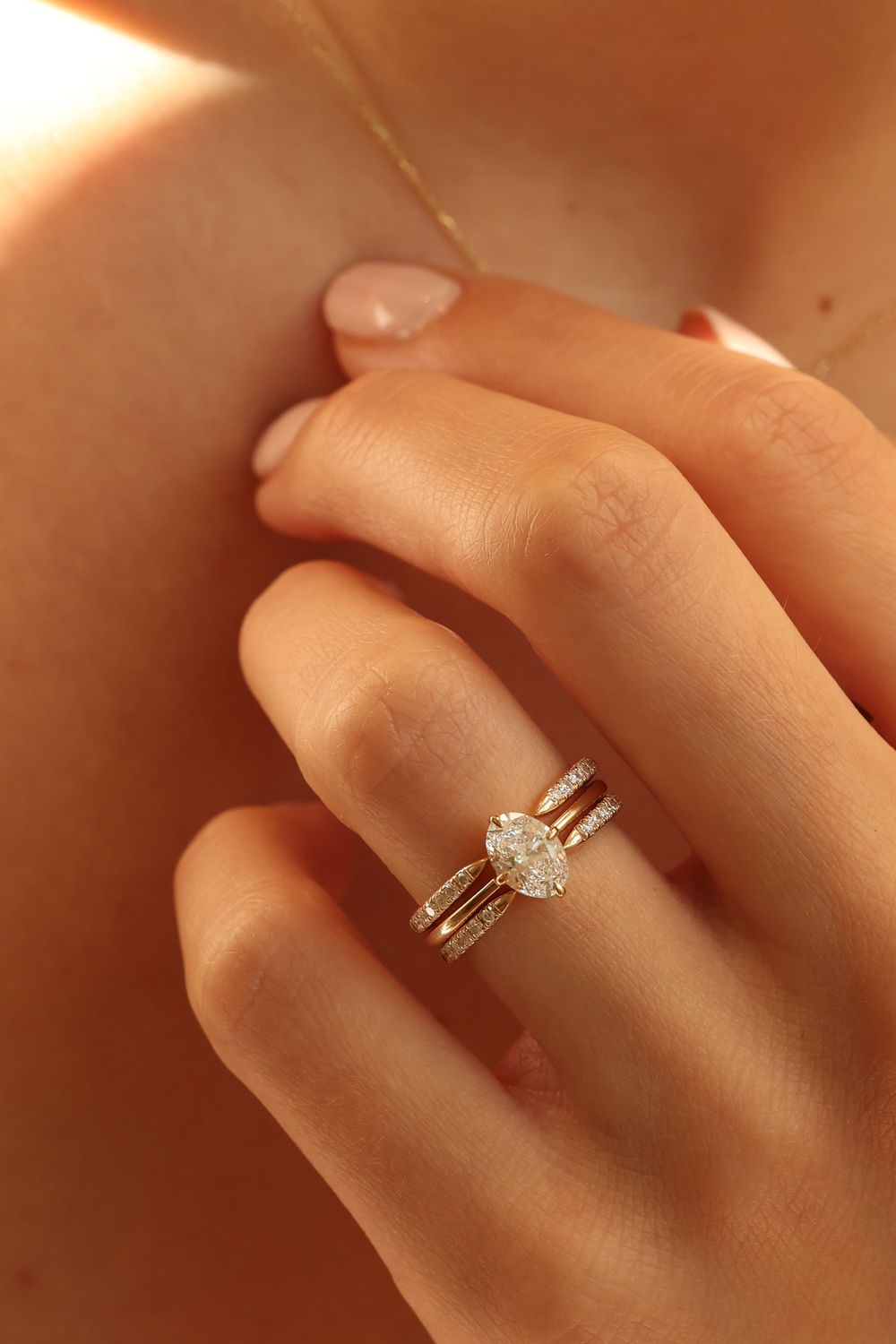Language and currency settings
Change your language and currency settings by selecting your preferences below
Select currency
Select language
Lab-Grown vs. Mined Diamonds: What’s the Difference?
What sets a lab-grown diamond apart from a mined diamond? Surprisingly, not much at all. Chemically, physically, and optically, they are indistinguishable, as they are essentially formed in different settings.

Above: Big Emerald Swan & Pavé
Mined diamonds originate from the depths of the earth, where they are believed to have taken shape around 1 to 3 billion years ago, a staggering 90 miles below the surface. The conditions down there were truly extraordinary. Carbon dioxide endured extreme temperatures surpassing 1093°C and immense pressure, before these diamonds were propelled from the Earth's core to its crust through a series of volcanic eruptions.

On the other hand, lab-grown diamonds are meticulously crafted to replicate the natural process. The carbon is exposed to controlled high temperatures and pressure, mirroring the conditions found in nature. However, the controlled environment ensures that there are no unexpected pyrotechnics or explosive phenomena involved.

The Creation Process
Diamonds produced in labs employ two primary methods: High Pressure-High Temperature (HPHT) and Chemical Vapor Deposition (CVD).
HPHT
In the HPHT method, a small diamond seed is embedded in carbon. The carbon is subjected to immense pressure, reaching approximately 1.5 million pounds per square inch, utilizing techniques like belt press, cubic press, or split-sphere press. As if that weren't intense enough, the carbon is then exposed to scorching temperatures exceeding 1482°C, reminiscent of the sensation upon disembarking a plane during a tropical getaway. Under this pressure and heat, the carbon begins to melt, forming a diamond around the initial seed, which is carefully cooled afterwards.
CVD
CVD involves placing a small diamond seed (often an HPHT diamond) inside a sealed chamber, which is then heated to over 760°C—a comfortably warm temperature, you could say. Carbon-rich gases, typically methane and hydrogen, are introduced and ionized into plasma using laser or microwave technology. This process breaks down the molecular bonds of the gases, allowing pure carbon to adhere to the seed and form a new diamond. Subsequent treatments such as heat, irradiation, or specialized techniques may be employed to enhance or alter the diamond's color after its growth.

MINED
In contrast to freshly cultivated lab diamonds, mined diamonds took shape between 1 to 3 billion years ago, deep beneath the Earth's surface. The process was essentially similar: carbon dioxide endured extreme temperatures and immense pressure before being transported from the Earth's core to its crust through Kimberlite Pipes—igneous rock formations resulting from volcanic activity and subsequent cooling.
The two primary types of diamond mines are open-pit and underground. Open-pit mining involves maintaining surface exposure throughout the extraction process, while underground mining necessitates horizontal or vertical tunnel entry. Heavy machinery and explosives are employed to clear away debris, leaving lasting scars on the Earth's surface. In certain instances, the mining process even involves the displacement of entire lakes and redirection of rivers.

Social Impact
LAB-GROWN
The process of growing diamonds in a laboratory offers complete control and transparency. It eliminates the need for involvement with opaque intermediaries, ensuring a fully traceable supply chain. Moreover, diamond labs embrace modernity, providing a safe working environment and often paying above-average wages to their employees.
In terms of worker safety, lab-grown diamonds boast an impeccable record with zero documented injuries per thousand workers annually.
MINED
Mined diamonds have gained notoriety recently due to their association with complex, untraceable, and unethical supply chains originating from conflict regions. This includes the infamous "blood diamonds," which are mined in war zones and sold to finance insurgencies, support warlords, or fund invading armies. Additionally, the mining process frequently entails substandard working conditions, meager wages, human rights violations, and the exploitation of child labor.
Diamond mining is also linked to pollution of local water sources due to the acid mine drainage resulting from the extraction of minerals from rocks.

Environmental Impact
LAB-GROWN
Lab-grown diamonds present a more environmentally friendly alternative with minimal impact on surrounding communities.
Extracting natural diamonds requires increasingly deep mining operations, resulting in extensive craters on the Earth's surface. In contrast, the production of lab-grown diamonds occupies significantly less space. Surprisingly, the energy required to extract an underground diamond surpasses the energy needed to create an above-ground lab-grown diamond. For example, De Beers' diamond mines consume an average of 80.3 kWh per carat, while the Canadian Diavik mines consume 66 kWh per carat. In contrast, a lab-grown diamond can be produced with as little as 36 kWh of energy for a 1-carat diamond.
A study conducted by Frost & Sullivan reveals that diamond-growing facilities are typically situated in areas that have negligible environmental impact and minimal disruption to local biodiversity. On average, they disturb a mere 0.07 square feet of land per carat and generate only 1 pound of mineral waste. The distinction is clear.
MINED
Unearthing a single 1-carat diamond necessitates sifting through 88,000 to 176,000 pounds of earth, all in the name of preserving its supposed rarity.
This mining process exacts a severe toll on the environment, leading to soil erosion, deforestation, displacement of communities, and the destruction of ecosystems. Delicate balances of biodiversity are severely disrupted, rendering the land unusable even after mining operations cease.
Rural communities residing in mining zones, often relying on the land for their livelihoods, are frequently compelled to relocate due to unhealthy living conditions. Although initial compensation is offered to prevent homelessness, these initiatives often foster dependency rather than facilitating rehabilitation and sustainable development.
Furthermore, Frost & Sullivan's study highlights that mined diamonds emit over 30 pounds of sulfur oxide and 125 pounds of carbon per carat, whereas lab-grown diamonds produce little to no gaseous emissions.

Quality & Pricing
LAB-GROWN
The process of creating lab-grown diamonds offers greater efficiency and cost-effectiveness compared to traditional mining. Each lab-grown diamond possesses its unique characteristics, and its quality is evaluated based on the four Cs (carat, color, clarity, and cut). As the techniques for creating lab-grown diamonds continue to advance, the price disparity between lab-grown and mined diamonds widens. Currently, lab-grown diamonds can be up to 30-60% less expensive than their mined counterparts of the same quality.
MINED
The high cost of mined diamonds is primarily driven by their perceived rarity, the challenges involved in mining, and clever marketing strategies. Unlike most commodities, the price of diamonds is not solely determined by supply and demand dynamics.

Both mined and lab-grown diamonds hold equal credibility. Even certified gemologists cannot distinguish between them. Major gemological laboratories, including the Gemological Institute of America (GIA), now grade both types of diamonds using the same criteria, underscoring the fact that regardless of their origin, a diamond is a diamond. Furthermore, the Federal Trade Commission recently revised the definition of a diamond, removing the term "natural." While mined diamonds formed over a span of 1 to 3 billion years, lab-grown diamonds can be created in less than a month. With equivalent quality assurance, the needless exploitation of our planet's resources becomes an unnecessary pursuit.
Conclusion
New ideas often provoke questions and doubts, and it's natural for humans to feel that way. Yet, as we educate ourselves, we gain a deeper understanding and build trust. When it comes to lab-grown diamonds, there's a prevalent misconception that they differ from mined diamonds. However, that's not the truth. As we've explored, lab-grown diamonds possess an identical chemical composition, while their creation in a controlled environment brings about substantial social and environmental benefits. This remarkable technological advancement holds immense potential to break the cycle of unethical mining and pave the way for a better future.
Join the Nangi family!
Read similar posts






Join the Nangi family!
Subscribe to our newsletter to be the first to know when we release new one-of-a-kind pieces, and gain exclusive access to secret sales and events
Norsk side
Nangi Fine Jewelry © 2024